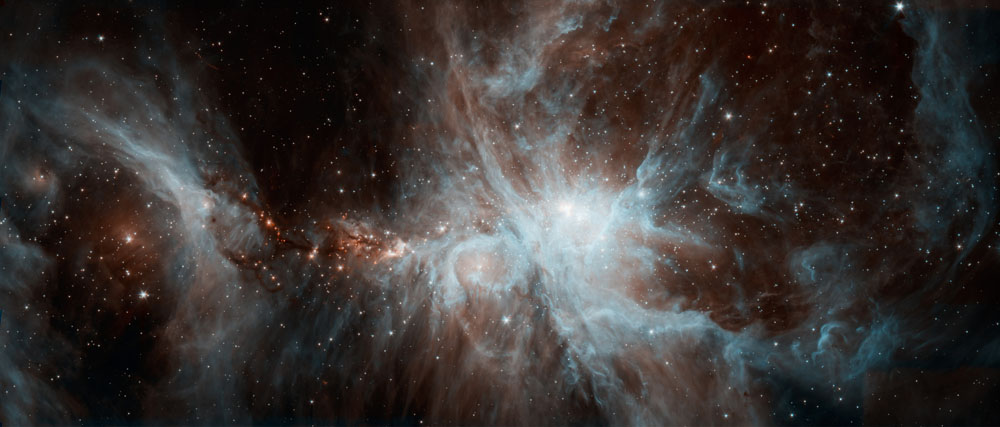Hot New Stars Take Center Stage in Cosmic Photo

Forhot, young stars, the Orion nebula seems like the place to be, according to astunning new image taken by a NASA telescope.
Thecluster of young stars in the sword of the famed constellation of Orion (TheHunter) stand out in a new infrared image from NASA's Spitzer Space Telescope,which captured the bustling group of cosmic orbs amid interstellar gas and dust.
Byclosely monitoring the young stars, scientists hope to learn more about whythe stars change, and to what degree planet formation might play a role.
"Thisis an exploratory project," said John Stauffer, the principal investigatorof the research at NASA's Spitzer Science Center, located at the CaliforniaInstitute of Technology in Pasadena, Calif. "Nobody has done this beforeat a wavelength sensitive to the heat from dust circling around so many stars.We are seeing a lot of variation, which may be a result of clumps of warpedstructures in the planet-forming disks."
Theimage of the young stars was taken after Spitzerran out of coolant in May 2009, which marked the beginning of its extended"warm" mission.
Thesuper-cold liquid helium coolant was used to keep the telescope?s instrument temperatureslow enough for detailed infrared observations. But Spitzer?s twoshortest-wavelength infrared channels can still function normally at the new,warmer temperature of minus 406 degrees Fahrenheit (minus 243 degrees Celsius).
Spitzertelescope?s infrared stare
Get the Space.com Newsletter
Breaking space news, the latest updates on rocket launches, skywatching events and more!
Inthis next phase of Spitzer'smission, the telescope is able to devote more time to projects that cover agreater expanse and require longer observation times.
Thatincludes the "Young Stellar Object Variability" program, in which Spitzeris staring at the same patch of the Orion nebula for extended periods toobserve the same cluster of about 1,500 variable stars over time.
Sofar, Spitzer has already taken approximately 80 photos of this set of starsover the course of 40 days. A second set of observations is planned for thefall.
Thestars in this region of the Orion nebula are approximately one million yearsold, which, in the cosmos, is still relatively young. In comparison, the sun is4.6 billion years old.
Asscientists note, these young stars do exhibit behavior that differs from moreadult sun-like stars. For one, the brightness levels of younger stars fluctuatemore, and the stars themselves spin faster.
Coldstars, hot stars
Onereason for the variations in stellar brightness is due to the existence of coldspots on the surface of the stars. Cold spots are more prevalent on young starsand come and go as the star spins, which changes the amount of light that canbe monitored by telescopes.
Stellarbrightness can also change as a result of hot spots, which are caused by gasthat accretes onto a young star from the material out of which it formed.
"Inthe 1950s and ?60s, astronomers knew that younger stars varied, and theypostulated this had something to do with the birthing process," Stauffersaid. "Later, with improved technology, we could see a lot more andlearned a great deal about the stars' spots."
Spitzer'sinfrared sight also has the ability to see the warm, dusty disks orbitingaround the stars. These disks are where planets may eventually clump togetherand form. By gathering more data on these varying disks, Stauffer and his teamhope to learn more about how planets develop.
- Images:Spitzer's Telescope?s Greatest Photos, Part2
- Out InSpace: The Major Space Telescopes
- Video:Spitzer's Warm Mission
Join our Space Forums to keep talking space on the latest missions, night sky and more! And if you have a news tip, correction or comment, let us know at: community@space.com.

Denise Chow is a former Space.com staff writer who then worked as assistant managing editor at Live Science before moving to NBC News as a science reporter, where she focuses on general science and climate change. She spent two years with Space.com, writing about rocket launches and covering NASA's final three space shuttle missions, before joining the Live Science team in 2013. A Canadian transplant, Denise has a bachelor's degree from the University of Toronto, and a master's degree in journalism from New York University. At NBC News, Denise covers general science and climate change.









